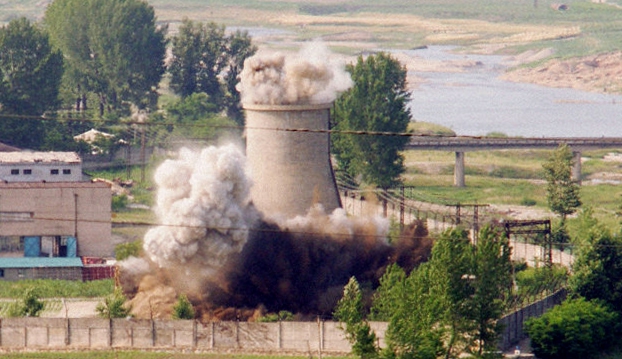 |
|
North Korea dynamites the cooling tower of its nuclear facility in Yongbyon on June 27, 2008. (Kyodo News/Yonhap News)
|
“North Korea could make Iran look easy,” says former US energy secretary
The greatest point of contention about the dismantlement of North Korea’s nuclear program – which is the crux of the agenda of the upcoming North Korea-US summit – is the transparent inspection and verification of its nuclear weapons, facilities and materials. Leading up to the first ever summit between US President Donald Trump and North Korean leader Kim Jong-un, the work of verifying North Korea’s denuclearization is expected to require the most sweeping inspections in the history of dismantling nuclear programs around the world. “North Korea could make Iran look easy,” former US Energy Secretary Ernest Moniz, who negotiated the details of the Iran nuclear deal in 2015, was quoted as saying in a May 6 article by the New York Times. Moniz was referring to the nuclear inspections that occurred in Iran as part of that deal. His point is that since North Korea’s nuclear capabilities are broader and more advanced than Iran’s, inspection and verification will be that much more difficult. North Korea has carried out six nuclear weapons tests so far, the last one occurring in Sept. 2017. After the test launching of its Hwasong-15 ICBM (intercontinental ballistic missile) in Nov. 2017, the North declared the “completion of its state nuclear force.” But the outside world does not exactly know the extent of North Korea’s nuclear arsenal, facilities and materials. According to a report by the Rand Corporation, North Korea possesses between 40 and 100 nuclear facilities, including its facility in Yongbyon. It has 400 buildings related to its nuclear program. At least two of these buildings contain nuclear reactors, one of which is presumed to be manufacturing plutonium, a raw material used to make nuclear weapons. A 2018 report on North Korea’s capabilities by the Bulletin of the Atomic Scientists estimates that the fissile materials that North Korea had produced by the end of 2017 include 20-40kg of plutonium and 250-500kg of high-enriched uranium. The Bulletin also estimated that North Korea has the ability to produce enough fissile material to manufacture six or seven atomic warheads a year and that it has completed between 16 and 32 warheads thus far. In contrast, the CIA (Central Intelligence Agency) believes that North Korea has an arsenal of about 20 nuclear warheads while the DIA (Defense Intelligence Agency) places that number to be around 60. This stands in sharp contrast with Iran, which only had about a dozen nuclear facilities and had not yet succeeded at developing nuclear warheads three years ago when it made its nuclear deal with six world powers, including the US, Germany and China. For this reason, the New York Times predicted that verifying North Korea’s denuclearization could require more than the 300-plus inspectors with the International Atomic Energy Agency (IAEA) who are currently working in over 200 countries around the world. The paper also pointed out that while IAEA inspectors are experts in the methods of transporting nuclear materials and in the equipment used to produce nuclear fuel, they are not trained to handle nuclear weapons. “Frankly, there’s a limit to the talent pool,” said David Kay, who headed up the US’s search for weapons of mass destruction in Iraq in 2003 and 2004. For these obstacles to be overcome, North Korea must disclose all the nuclear weapons, facilities and materials in its possession and cooperate fully with verification. The New York Times was skeptical about the prospects of this. North Korean leader Kim Jong-un recently said he would allow the foreign press and experts to observe the shutdown of the nuclear test site at Punggye Village. By Hwang Joon-bum, staff reporter Please direct comments or questions to [english@hani.co.kr]






